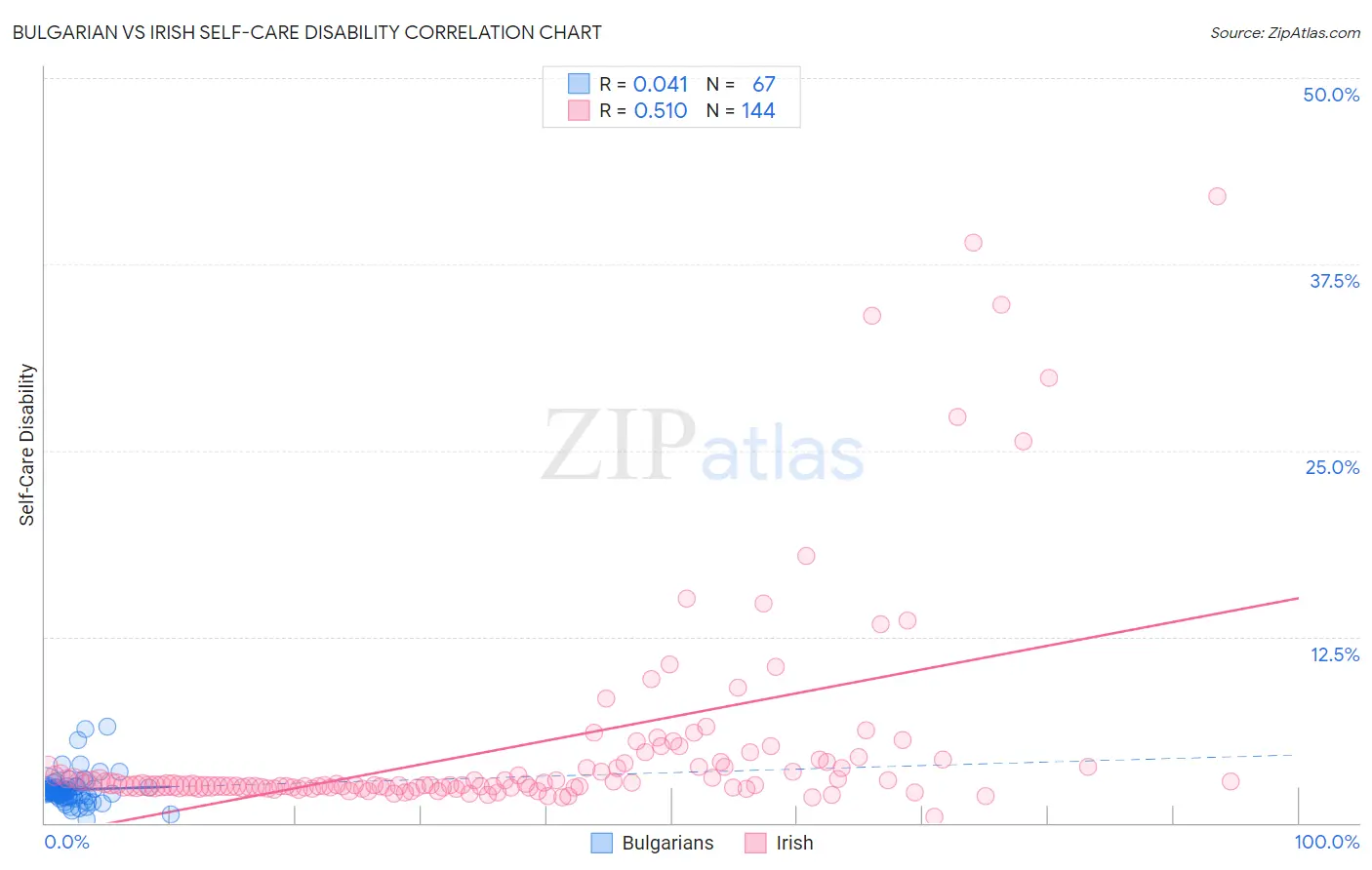Bulgarian vs Irish Self-Care Disability
COMPARE
Bulgarian
Irish
Self-Care Disability
Self-Care Disability Comparison
Bulgarians
Irish
2.2%
SELF-CARE DISABILITY
100.0/ 100
METRIC RATING
21st/ 347
METRIC RANK
2.5%
SELF-CARE DISABILITY
28.7/ 100
METRIC RATING
187th/ 347
METRIC RANK
Bulgarian vs Irish Self-Care Disability Correlation Chart
The statistical analysis conducted on geographies consisting of 205,516,049 people shows no correlation between the proportion of Bulgarians and percentage of population with self-care disability in the United States with a correlation coefficient (R) of 0.041 and weighted average of 2.2%. Similarly, the statistical analysis conducted on geographies consisting of 577,353,633 people shows a substantial positive correlation between the proportion of Irish and percentage of population with self-care disability in the United States with a correlation coefficient (R) of 0.510 and weighted average of 2.5%, a difference of 11.9%.

Self-Care Disability Correlation Summary
| Measurement | Bulgarian | Irish |
| Minimum | 0.21% | 0.44% |
| Maximum | 6.5% | 42.0% |
| Range | 6.2% | 41.6% |
| Mean | 2.2% | 5.0% |
| Median | 2.1% | 2.6% |
| Interquartile 25% (IQ1) | 1.7% | 2.4% |
| Interquartile 75% (IQ3) | 2.4% | 3.9% |
| Interquartile Range (IQR) | 0.68% | 1.5% |
| Standard Deviation (Sample) | 1.1% | 7.0% |
| Standard Deviation (Population) | 1.1% | 7.0% |
Similar Demographics by Self-Care Disability
Demographics Similar to Bulgarians by Self-Care Disability
In terms of self-care disability, the demographic groups most similar to Bulgarians are Immigrants from Venezuela (2.2%, a difference of 0.040%), Tongan (2.2%, a difference of 0.25%), Cambodian (2.2%, a difference of 0.25%), Immigrants from Eritrea (2.2%, a difference of 0.33%), and Cypriot (2.2%, a difference of 0.55%).
| Demographics | Rating | Rank | Self-Care Disability |
| Luxembourgers | 100.0 /100 | #14 | Exceptional 2.2% |
| Okinawans | 100.0 /100 | #15 | Exceptional 2.2% |
| Immigrants | Kuwait | 100.0 /100 | #16 | Exceptional 2.2% |
| Immigrants | Saudi Arabia | 100.0 /100 | #17 | Exceptional 2.2% |
| Immigrants | Taiwan | 100.0 /100 | #18 | Exceptional 2.2% |
| Immigrants | Eritrea | 100.0 /100 | #19 | Exceptional 2.2% |
| Tongans | 100.0 /100 | #20 | Exceptional 2.2% |
| Bulgarians | 100.0 /100 | #21 | Exceptional 2.2% |
| Immigrants | Venezuela | 100.0 /100 | #22 | Exceptional 2.2% |
| Cambodians | 100.0 /100 | #23 | Exceptional 2.2% |
| Cypriots | 100.0 /100 | #24 | Exceptional 2.2% |
| Turks | 100.0 /100 | #25 | Exceptional 2.2% |
| Immigrants | Sri Lanka | 99.9 /100 | #26 | Exceptional 2.2% |
| Venezuelans | 99.9 /100 | #27 | Exceptional 2.2% |
| Inupiat | 99.9 /100 | #28 | Exceptional 2.2% |
Demographics Similar to Irish by Self-Care Disability
In terms of self-care disability, the demographic groups most similar to Irish are Immigrants from Oceania (2.5%, a difference of 0.030%), Immigrants from Eastern Europe (2.5%, a difference of 0.040%), Immigrants from El Salvador (2.5%, a difference of 0.23%), Sioux (2.5%, a difference of 0.25%), and Slavic (2.5%, a difference of 0.31%).
| Demographics | Rating | Rank | Self-Care Disability |
| Indonesians | 41.2 /100 | #180 | Average 2.5% |
| Ghanaians | 40.4 /100 | #181 | Average 2.5% |
| Maltese | 37.5 /100 | #182 | Fair 2.5% |
| Salvadorans | 36.4 /100 | #183 | Fair 2.5% |
| Yugoslavians | 36.1 /100 | #184 | Fair 2.5% |
| Slavs | 34.3 /100 | #185 | Fair 2.5% |
| Immigrants | El Salvador | 33.0 /100 | #186 | Fair 2.5% |
| Irish | 28.7 /100 | #187 | Fair 2.5% |
| Immigrants | Oceania | 28.3 /100 | #188 | Fair 2.5% |
| Immigrants | Eastern Europe | 28.0 /100 | #189 | Fair 2.5% |
| Sioux | 24.6 /100 | #190 | Fair 2.5% |
| Moroccans | 22.9 /100 | #191 | Fair 2.5% |
| Soviet Union | 22.2 /100 | #192 | Fair 2.5% |
| Ukrainians | 21.4 /100 | #193 | Fair 2.5% |
| Immigrants | Germany | 17.9 /100 | #194 | Poor 2.5% |